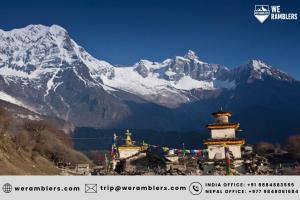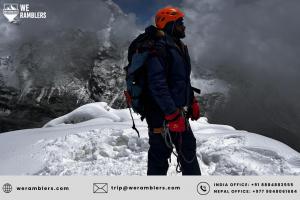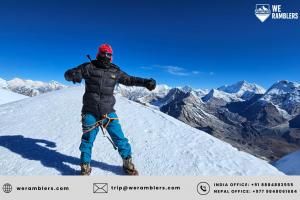We Ramblers Introduces Life-Changing Peak Climbing Experiences with Guided Climbs to Mera, Island & Lobuche Peaks
We Ramblers launches 2025 Himalayan climbs for Mera, Island & Lobuche Peaks, offering guided, safe, and life-changing adventures in Nepal’s majestic mountains
“Our goal is to make Himalayan climbing accessible, safe, and deeply inspiring for everyone who dreams of standing atop these majestic peaks,” said the founder of We Ramblers”
BANGALORE, KARNATAKA, INDIA, October 28, 2025 /EINPresswire.com/ -- We Ramblers, a leading adventure travel company with offices in Kathmandu and Bangalore, proudly announces its 2025 Himalayan climbing expeditions for three iconic peaks: Mera Peak (6,476m), Island Peak (6,165m), and Lobuche Peak (6,145m). These expeditions combine world-class adventure with professional safety standards, cultural immersion, and unmatched expertise. As pioneers of adventure tourism across Nepal, Tibet, Bhutan, and India, We Ramblers invites thrill-seekers, aspiring mountaineers, and adventure enthusiasts to join guided climbs designed to deliver life-changing experiences in the heart of the Himalayas.— Subid Sahoo
Mera Peak Climb
Mera Peak (6,476 m / 21,247 ft) is the highest trekking peak in Nepal and one of the most rewarding climbs for adventure seekers who dream of summiting a Himalayan giant. Located in the remote Hinku Valley, this climb offers breathtaking panoramas of five of the world’s highest peaks: Everest, Kanchenjunga, Lhotse, Makalu, and Cho Oyu. Unlike purely technical ascents, Mera Peak is considered an achievable climb for those with basic mountaineering skills, making it one of the best choices for trekkers eager to experience high-altitude climbing in the Himalayas. With a blend of scenic trekking trails, traditional Sherpa villages, and glacier walking, the Mera Peak Climb provides an unforgettable Himalayan experience for both seasoned climbers and ambitious adventurers.
Best Time to Climb Mera Peak
The best seasons for climbing Mera Peak are spring (April–May) and autumn (October–November). During these windows, the weather is stable, visibility is clear, and the trails are alive with vibrant energy. Spring brings blossoming rhododendron forests, warmer daytime temperatures, and excellent mountain views, while autumn offers crisp skies, cooler nights, and some of the clearest Himalayan panoramas of the year.
Climbers are strongly advised to avoid the monsoon season (June–August), when heavy rainfall makes the trails muddy and landslides more likely, and the winter months (December–February), when extreme cold and heavy snowfall can make the climb dangerous.
Departure Dates (Autumn 2025)
For 2025, We Ramblers has fixed group departures for the Mera Peak Climb to ensure climbers can join well-organized expeditions with full logistical support.
04 October 2025
11 October 2025
18 October 2025
25 October 2025
01 November 2025
08 November 2025
15 November 2025
22 November 2025
These dates align perfectly with Nepal’s peak climbing season, maximizing success rates while ensuring safe and enjoyable conditions.
Mera Peak Climb Itinerary (All Inclusive)
Day 1: Arrival in Kathmandu (1,400 m / 4,594 ft)
Upon landing in Nepal’s bustling capital, trekkers are greeted by the We Ramblers team and transferred to a comfortable hotel. After a group briefing and permit checks, the day is free to explore Kathmandu’s vibrant markets and historic temples.
Day 2: Kathmandu to Lukla (2,860 m) – 35-minute flight
A thrilling mountain flight takes adventurers to Lukla, the gateway to the Himalayas. With views of Everest and surrounding peaks, the day ends in a tea house in Lukla.
Day 3: Lukla to Chuthanga (3,200 m)
The trek begins with a moderate 3–4 hour hike through forests and suspension bridges, finishing in the small village of Chuthanga.
Day 4: Chuthanga to Kharki Thanga (3,700 m)
A steep uphill trek through rhododendron forests brings the group to Kharki Thanga, a remote acclimatization spot surrounded by mountains.
Day 5: Kharki Thanga to Chatra Khola (4,200 m) via Zatrwa-La Pass (4,600 m)
The day starts early with a challenging pass crossing before descending into Chatra Khola, offering majestic mountain views and prayer-flag-lined ridges.
Day 6: Chatra Khola to Kothe (3,691 m)
Trekkers cross rolling hills and descend through rhododendron and pine forests into the charming village of Kothe.
Day 7: Kothe to Thangnak (4,358 m)
The trail follows a riverbed with views of Mera Peak, passing a monastery before reaching the tea house settlement of Thangnak.
Day 8: Thangnak to Khare (5,045 m)
A scenic trek leads past glacier lakes and flat valleys to Khare, the last permanent settlement before the climb.
Day 9: Acclimatization and Training in Khare
A rest and training day where climbers practice rope techniques, crampon use, and glacier skills under the guidance of professional Sherpa leaders.
Day 10: Khare to Mera Base Camp (5,350 m)
The journey continues uphill through rocky terrain, arriving at base camp for the first night of camping under the stars.
Day 11: Mera Base Camp to High Camp (5,780 m)
Climbers put on crampons for their first glacier walk, ascending through endless snowfields to the thrilling Mera High Camp.
Day 12: Summit Day – Mera Peak (6,461 m)
An early alpine start leads to the summit of Mera Peak. The ascent takes 4–6 hours with stunning views of Everest, Lhotse, Makalu, Kanchenjunga, and Cho Oyu. After celebrating at the summit, climbers descend back to Khare.
Day 13: Khare to Kothe (3,691 m)
The descent begins, retracing the route through forests and alpine villages.
Day 14: Kothe to Chatra Khola (4,200 m)
A longer day of ups and downs across mountain passes leads back to Chatra Khola.
Day 15: Chatra Khola to Lukla (2,860 m)
Crossing the Zatrwa-La Pass again, climbers make their final descent into Lukla for a well-earned rest.
Day 16: Lukla to Kathmandu (1,400 m)
A short mountain flight (or drive via Ramechhap if required) brings the team back to Kathmandu for a final celebration.
Day 17: Departure Day
The Mera Peak adventure concludes with airport transfers and farewells, marking the end of an unforgettable Himalayan expedition.
Key Highlights of the Mera Peak Climb
Achievable Himalayan Summit: At 6,476 m, Mera Peak is Nepal’s highest trekking peak, offering a true mountaineering challenge accessible to fit trekkers with basic climbing skills.
Spectacular Panoramas: From the summit, climbers enjoy views of five 8,000-meter giants: Everest, Lhotse, Makalu, Cho Oyu, and Kanchenjunga.
Rich Cultural Immersion: Trails pass through Sherpa villages, monasteries, and pristine forests, blending adventure with cultural discovery.
Professional Training: Dedicated acclimatization and technical training sessions in Khare prepare climbers for glacier travel and summit success.
Safe and Supportive Experience: High staff-to-client ratios, insured local guides, and world-class logistics ensure maximum safety and comfort.
Unforgettable Adventure: A perfect mix of trekking, camping, glacier walking, and high-altitude climbing makes the Mera Peak expedition one of Nepal’s most rewarding adventures.
Island Peak Climb
Island Peak, also known as Imja Tse, is one of Nepal’s most popular trekking peaks and serves as the perfect introduction to Himalayan mountaineering. Standing tall at an altitude of 6,165 meters (20,226 ft), it offers adventure seekers a thrilling yet achievable climbing experience, combining breathtaking trekking routes in the Everest region with an exhilarating alpine ascent. Often considered the training ground for future high-altitude expeditions like Everest, Lhotse, and Makalu, Island Peak rewards climbers with stunning panoramic views of some of the highest peaks on Earth.
Best Time to Climb Island Peak
The best time to climb Island Peak is during the pre-monsoon (spring) season from March to May and the post-monsoon (autumn) season from late September to November.
Spring (March–May): Clear skies, warmer days, and a vibrant environment with blooming rhododendrons. This season is favored by climbers preparing for Everest and other 8,000-meter expeditions.
Autumn (September–November): Known for crisp mountain air, stable weather, and some of the clearest views of the Himalayas. This is the most popular season for Island Peak climbing due to reliable conditions.
Winter climbs are possible but require more preparation for extreme cold, while the monsoon (June–August) is generally avoided due to heavy rainfall, slippery trails, and poor visibility.
Departure Dates for Island Peak Climb (2025)
We Ramblers offers multiple group departures in autumn 2025 to maximize flexibility for trekkers and climbers:
04-Oct-2025
11-Oct-2025
18-Oct-2025
25-Oct-2025
01-Nov-2025
08-Nov-2025
15-Nov-2025
22-Nov-2025
Custom private expeditions can also be arranged for individuals, families, or groups outside these dates.
Island Peak Climb Itinerary (All-Inclusive)
Day 1: Arrival in Kathmandu (1,400m)
Airport pick-up, hotel check-in at Thamel, trip briefing, and leisure time for shopping or local sightseeing.
Day 2: Kathmandu to Lukla (2,860m) – Trek to Phakding (2,652m)
A scenic 35-minute flight to Lukla, followed by a 3-hour trek along the Dudhkoshi River to Phakding.
Day 3: Phakding to Namche Bazaar (3,440m)
A 6–7 hour trek through suspension bridges, Sagarmatha National Park entry, and first views of Everest before arriving at bustling Namche.
Day 4: Namche Bazaar to Khumjung (3,790m)
Short trek with panoramic views of Everest, Lhotse, and Ama Dablam. Visit to Namche Museum and Khumjung Monastery.
Day 5: Khumjung to Debuche (3,800m)
Trek past Tengboche Monastery, famous for spiritual blessings, before descending through rhododendron forests to Debuche.
Day 6: Debuche to Dingboche (4,410m)
Pass Pangboche village and enjoy magnificent Ama Dablam views before reaching Dingboche for overnight stay.
Day 7: Dingboche to Chhukung (4,730m)
Short trek through Imja Valley with views of Island Peak, Nuptse, and Lhotse.
Day 8: Rest Day in Chhukung
Acclimatization day with optional short hikes.
Day 9: Chhukung to Island Peak Base Camp (5,100m)
3–4 hour trek over moraines, followed by pre-climb training on climbing equipment and rope techniques.
Day 10: Summit Day – Island Peak (6,165m)
Start early (around midnight), cross crevasses with ladders, climb the famous 100-meter ice wall, and reach the summit ridge for breathtaking views. Return to Chhukung for an overnight stay.
Day 11: Chhukung to Namche Bazaar (3,440m)
A long descent via Dingboche, Pangboche, and Tengboche, arriving back in Namche.
Day 12: Namche to Lukla (2,860m)
Final trek back to Lukla, marking the end of the trail section.
Day 13: Lukla to Kathmandu (1,400m)
Return flight to Kathmandu, followed by leisure and farewell dinner.
Day 14: Departure
Final goodbyes and airport transfer for onward journey.
Key Highlights of Island Peak Climb
Thrilling Summit Experience: Conquer the 6,165-meter Island Peak, with rope, ladder, and ice wall climbs.
Everest Region Trekking: Walk the iconic Khumbu trail with visits to Namche Bazaar, Tengboche, and Dingboche.
Cultural Immersion: Experience Sherpa traditions, monasteries, and warm hospitality in Himalayan villages.
Pre-Climb Training: Hands-on practice with professional climbing guides at base camp for rope handling, crampons, and ice axes.
Panoramic Views: Witness jaw-dropping sights of Lhotse, Makalu, Ama Dablam, Baruntse, and Nuptse.
Safety & Expertise: Guided by insured, licensed Sherpa professionals with years of mountaineering experience.
All-Inclusive Package: Flights, accommodation, meals, permits, and logistics fully managed by We Ramblers.
Lobuche Peak Climb
The Lobuche Peak Climb is one of Nepal’s most thrilling trekking peak expeditions, ideal for climbers who want to combine the classic Everest Base Camp Trek with a high-altitude summit adventure. At an altitude of 6,145 meters (20,161 ft), Lobuche East offers an exciting challenge for climbers, with sections requiring technical gear, ropework, and crampons. Unlike Island Peak or Mera Peak, Lobuche is known for its close-up views of Everest, Lhotse, Nuptse, and Makalu, making it a dream climb for mountaineers seeking Himalayan grandeur without committing to an 8,000-meter expedition.
Best Time to Climb Lobuche Peak
The best time to climb Lobuche Peak is during the spring (March to May) and autumn (late September to November) seasons.
Departure Dates for Lobuche Peak Climb (2025)
We Ramblers offers multiple scheduled group departures in autumn 2025:
25-Oct-2025
01-Nov-2025
08-Nov-2025
15-Nov-2025
22-Nov-2025
Private departures are also available for climbers seeking custom itineraries or exclusive guided trips.
Lobuche Peak Climb Itinerary
Day 1: Arrival in Kathmandu – Hotel check-in, briefing, and last-minute gear shopping.
Day 2: Flight to Lukla – Trek to Phakding (2,652m) – Scenic 35-minute flight, followed by a 3-hour trek along rivers and Sherpa settlements.
Day 3: Trek to Namche Bazaar (3,440m) – Cross suspension bridges and enter Sagarmatha National Park before ascending to Namche.
Day 4: Namche to Khumjung (3,790m) – Acclimatization trek via Everest View Hotel and Khumjung Monastery.
Day 5: Khumjung to Debuche (3,860m) – Visit Tengboche Monastery before descending to Debuche.
Day 6: Debuche to Pheriche (4,371m) – Trek via Pangboche with dramatic Ama Dablam views.
Day 7: Pheriche to Thukla (4,620m) – Short, acclimatization trek to Dughla, offering views of Lobuche Peak.
Day 8: Thukla to Lobuche (4,950m) – Visit climbers’ memorials at Dughla Pass before reaching Lobuche village.
Day 9: Trek to Gorakshep (5,170m) – Everest Base Camp (5,364m) – Full-day trek to EBC and return to Gorakshep.
Day 10: Kala Patthar (5,645m) – Return to Lobuche – Sunrise climb to Kala Patthar, followed by descent to Lobuche.
Day 11: Rest Day in Lobuche (4,950m) – Important acclimatization day before the summit push.
Day 12: Trek to Lobuche Peak High Camp (5,400m) – Short trek and training session on climbing techniques.
Day 13: Summit Day (6,145m) – Descend to Pheriche – Early climb via crampon point, fixed ropes, and snowy slopes to summit Lobuche East. Descent to Pheriche.
Day 14: Trek to Namche Bazaar (3,440m) – Retrace trail through Tengboche and Pangboche.
Day 15: Trek to Lukla (2,860m) – Final trek through Monjo and Phakding.
Day 16: Flight to Kathmandu – Return flight and celebratory evening in the capital.
Day 17: Departure – Final airport drop-off.
About We Ramblers
Founded in 2013, We Ramblers has become one of Nepal’s most trusted adventure travel companies, offering a wide range of trekking, climbing, and cultural experiences. With headquarters in Kathmandu, Nepal, and a branch office in Bangalore, India, the company operates across the Himalayas in Nepal, Tibet, Bhutan, and India. We Ramblers pioneered treks in the Everest, Annapurna, Mustang, Dolpo, Humla, Langtang, Manaslu, and Dhaulagiri regions, introducing travelers to both popular and offbeat routes.
Subid Sahoo
We Ramblers
+91 98862 74292
email us here
Visit us on social media:
Instagram
Facebook
YouTube
X
Other
Legal Disclaimer:
EIN Presswire provides this news content "as is" without warranty of any kind. We do not accept any responsibility or liability for the accuracy, content, images, videos, licenses, completeness, legality, or reliability of the information contained in this article. If you have any complaints or copyright issues related to this article, kindly contact the author above.



